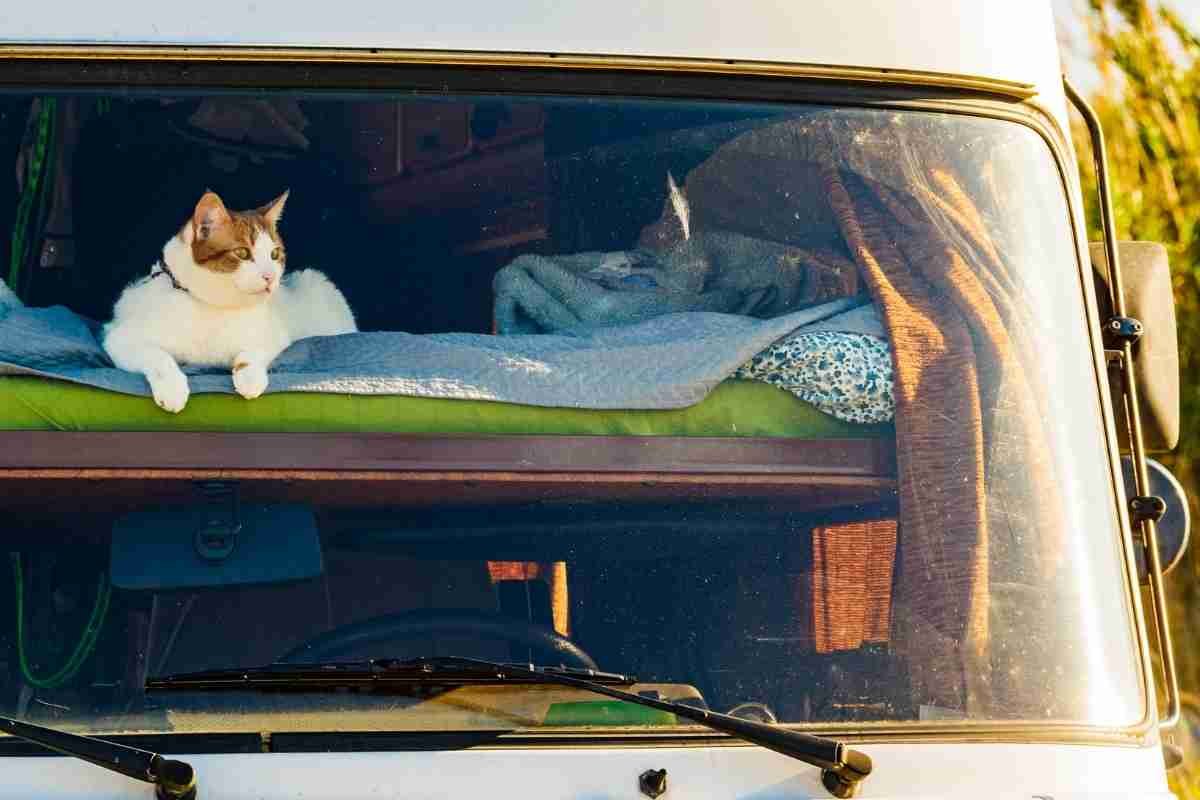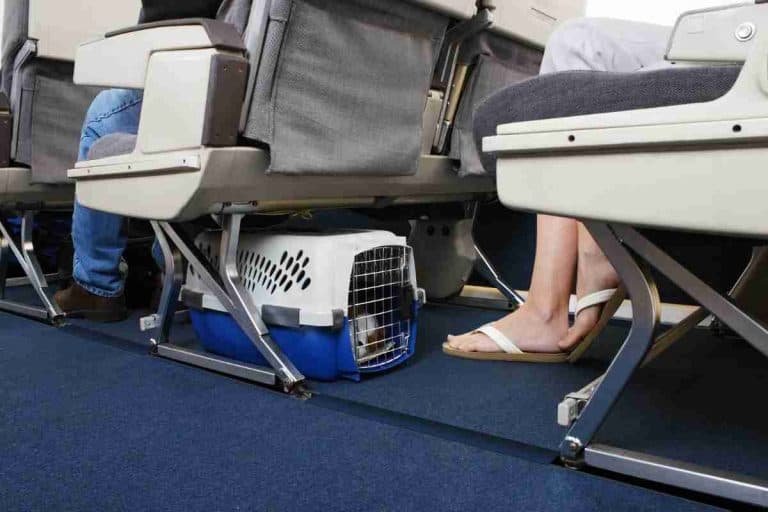15 Essential Tips for Traveling with Cats in an RV
Last Updated on August 24, 2025
Traveling with cats in an RV demands smart prep and calm routines. The right plan reduces stress, prevents escapes, and keeps road days predictable. From updated microchips and vet paperwork to carrier training and route mapping, RV travelers can set cats up for success.
These 15 essential tips cover cat-proofed interiors, safe restraints, litter and feeding fixes, and motion-sickness control. They also guide pet-friendly stops, campground etiquette, climate monitoring, supervised outdoor time, and emergency care. With practical steps and simple checklists, owners can turn an RV into a cat-friendly home on wheels.
Prepare your cat and paperwork before the trip
Preparing a cat and its paperwork reduces stress and prevents headaches on the road. Owners should assemble a dedicated travel folder with hard copies and scanned files of vaccination records, prescription instructions, and proof of ownership. Secure a sturdy carrier that fits the RV layout and a loose-fitting breakaway collar for quick ID. Introduce the carrier and the RV interior gradually, using short sessions so the cat associates the space with safety and positive reinforcement. Confirm pet policies for planned campgrounds and any state or local animal regulations that might apply during the route. Finally, pack an easily accessible emergency kit that includes basic first-aid items, a recent photo of the cat, and contact information for the primary veterinarian. These steps set the stage for vet visits, ID updates, temperament assessment, and route planning covered below.
Vet checkup, vaccinations and prescriptions
Schedule a vet visit six weeks before departure. The vet will confirm core vaccinations, update rabies documentation, and advise on region-specific shots. Discuss motion sickness, anxiety, and pain-control options. The veterinarian can prescribe anti-nausea or anti-anxiety medications when appropriate, and must provide written dosing instructions. Request extra labeled medication bottles and a printed prescription note for refills at pharmacies along the route. Ask the clinic for a copy of recent medical history and any chronic-condition care plan. If the cat requires controlled medications, obtain a signed letter explaining the medical need for travel. Store medicines in a waterproof bag, and keep one set in the RV’s cabin and a backup in checked luggage. For tips on calming a cat in vehicles during vet trips, see how to calm down a cat in the car.
Update microchip and ID tags; carry copies of records
Confirm the microchip number and update the registry contact details before leaving. Owners often forget to change phone numbers or seasonal addresses; this step prevents costly delays if a pet is lost. Attach an ID tag with a cell number, a temporary RV contact, and a campsite name when possible. Use a durable, legible tag and a breakaway collar to reduce entanglement risk. Photocopy and scan vaccination records, microchip registration, and ownership proof. Store digital files in at least two cloud services and carry printed sets in a weatherproof envelope. Keep one printed packet in the driver area and another in the luggage area. Add local emergency contacts and a recent photo of the cat to every copy. For practical escape-prevention and containment methods tailored to RV life, consult how to keep cats from escaping RV.
Assess your cat’s temperament and decide if RV life suits them
Not every cat adapts to RV life. Evaluate temperament across three domains: stress response, social tolerance, and environmental curiosity. Cats that freeze, hide, or display aggressive behavior under minor changes likely will not enjoy prolonged RV travel. Conduct staged trials: short drives, overnight stays in quiet parks, and time inside the parked RV. Monitor eating, litter-box habits, and vocalization during each trial. Teach the cat to accept confinement in the carrier for long stretches and practice safe leash walking if exits are likely. Use positive reinforcement to reward calm behavior and consult a certified behaviorist for pronounced anxiety. If the cat shows persistent distress, consider alternative care options during long legs of the trip. For strategies on traveling with a picky or nervous cat, review how to travel with a fussy feline. A careful temperament assessment prevents traumatic experiences on the road.
Create a travel plan with pet-friendly stops and vets along the route
Build a route that balances driving time and predictable stops. Limit daily travel blocks to durations the cat tolerates, typically three to five hours with breaks. Identify veterinary clinics and emergency hospitals within a reasonable radius of each planned overnight stop. Save clinic hours, addresses, and phone numbers to a shared cloud document and to the phone’s favorites. Research pet-friendly campgrounds and read recent reviews for cleanliness and cat policies. Schedule predictable feeding and play windows to preserve routine. Pack familiar enrichment items—blankets, a favorite toy, and a portable litter box—and place them in consistent locations at each stop. Consider small RV modifications that increase safe, vertical space for the cat. For ideas on practical RV adjustments that improve feline comfort, see RV modifications for cats. Before departure, save all emergency contacts and clinic locations to an offline map for areas with limited reception.
Slowly introduce your cat to the RV and travel routines
A gradual approach reduces fear and builds confidence. Begin with short, predictable exposures and reward calm behavior. Keep the cat’s environment familiar by using the same bed, blanket, and toys inside the RV. Always move at the cat’s pace and avoid forcing interactions.
Short practice drives and staged overnight stays
Start by placing the carrier in a stationary RV with the engine off. Offer treats and quiet praise for entering the carrier. Progress to short drives of five to fifteen minutes, then return home so the cat associates the trip with a safe ending. Once short drives go well, try a nearby campground for a single overnight before extended travel. For techniques to reduce car anxiety, see how to calm down a cat in the car.
Carrier and crate desensitization techniques
Leave the carrier open in the living area with soft bedding and high-value treats. Feed meals near and eventually inside the carrier. Move the carrier into the RV living space so it becomes a resting spot, not a trap. Short, frequent sessions work better than long ones. Consider synthetic pheromone sprays or plug-ins to create a consistent calming scent.
Establish consistent feeding, play, and sleep routines
Set fixed feeding times and a predictable play schedule to anchor the cat’s day. Schedule a ten-minute play session before travel to reduce excess energy. Place the litter box in a quiet, easy-to-access spot and keep the same litter type. Consistent routines help the cat anticipate events and reduce anxiety.
Signs of stress and how to respond calmly
Watch for hiding, excessive vocalizing, panting, pacing, refusal to eat, or inappropriate elimination. Respond by pausing travel, offering a quiet refuge, and speaking softly. Use familiar items and rewards to reinforce calm behavior. If signs persist, consult a veterinarian about behavioral strategies or short-term medications before continuing the trip.
Outfit and cat-proof the interior of your RV
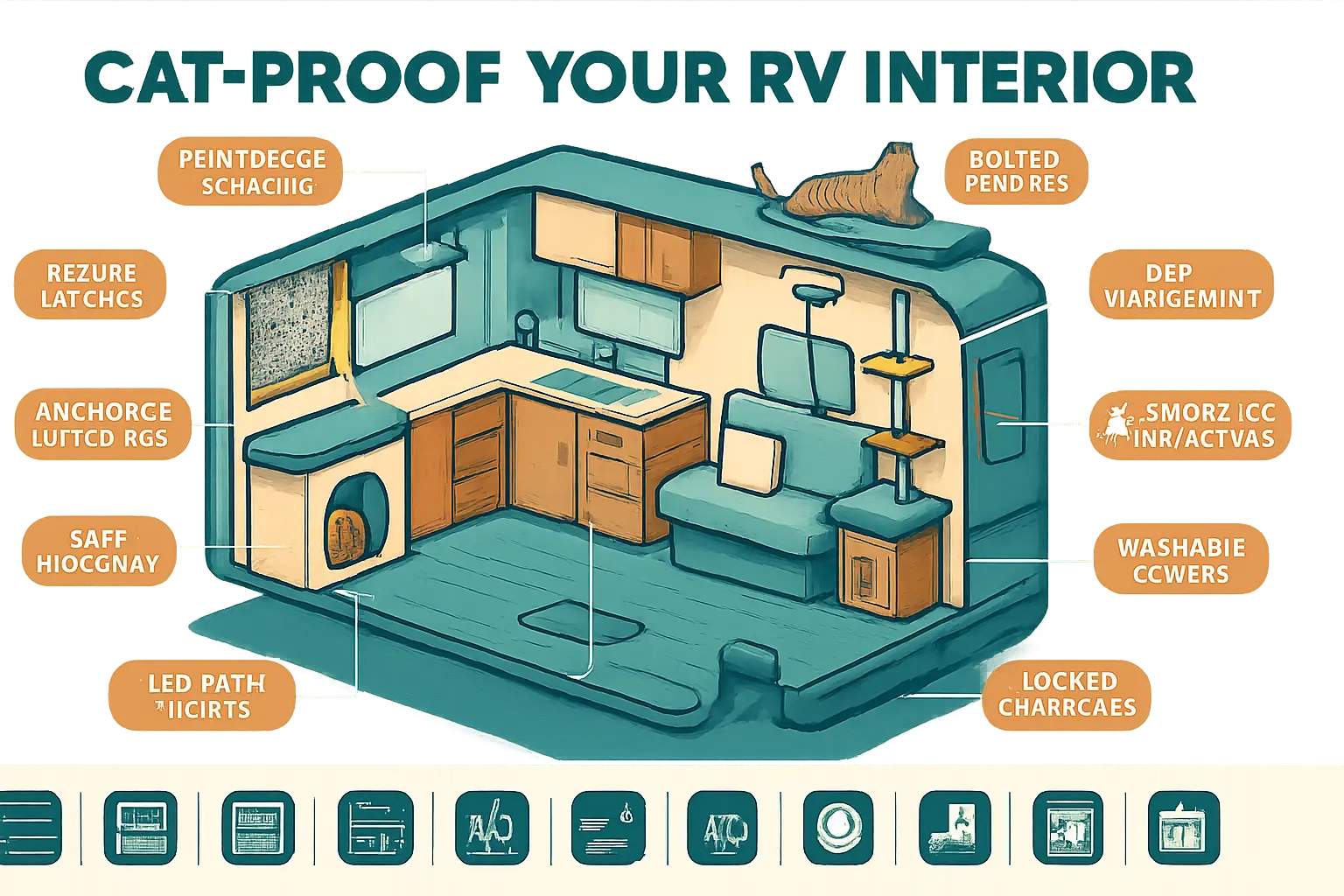
Outfitting an RV for feline travelers starts with practical, targeted changes. Choose hard-wearing, washable fabrics for cushions and curtains. Replace loose throw pillows with zippered, machine-washable covers and secure rugs with non-slip pads. Place a few low-profile, screwed-down cat beds and bolted wall shelves for resting spots that won’t slide during transit. Remove small, ingestible items from countertops and store them in lidded bins attached to shelves.
Install motion-safe LED lights in low areas to reduce startle reactions at night. Use cord concealers for electrical cords and mount smoke and CO detectors away from food-prep zones but within earshot. Keep a small toolkit, first-aid kit, and a travel-sized litter scoop in the same lockable cabinet for easy access.
For inspiration on durable, cat-focused changes and hardware ideas, see RV modifications for cats. Owners should perform a quick safety audit before each trip to confirm locks, latches, and covers remain secure.
Designate safe hideaways and elevated perches
Cats travel best when they have predictable, secure retreats. Create two types of refuges: a dark, enclosed hideaway near the sleeping area and an elevated perch with a view. Enclosed hideaways reduce stress during driving and storms. Use ventilated plastic bins with cut-outs or a collapsible carrier with soft bedding anchored to a shelf.
Elevated perches help cats observe the environment without feeling trapped. Install corner-mounted shelves or a cat tree secured to the floor and ceiling with tension poles. Add non-slip pads and bolted brackets so perches remain stable on winding roads.
Place a familiar blanket and a worn T-shirt with the owner’s scent inside each refuge. Rotate hideaway locations during short practice drives to build confidence. For behavior-focused calming strategies and travel acclimation tips, consult how to calm down a cat in the car.
Secure loose items, appliances and cabinets
Loose objects become hazards when the RV moves. Lock cabinets with childproof latches that withstand vibration. Use magnetic catches and automotive-grade Velcro for lightweight doors and drawers. Place heavy appliances and jars low and close to bulkheads to minimize shifting.
Secure small items in plastic bins with bungee cords or straps. Bolt down the litter box in a discrete holder to prevent spills. For larger appliances, add anti-tip brackets or straps that anchor to studs or wheel wells. Keep cleaning chemicals in a locked, vented cabinet to prevent ingestion and fumes.
For carrier and restraint advice that translates to interior securing methods, review how to secure a cat carrier in car. Owners should test each latch and strap before departure and after extended driving periods.
Reinforce screens, doors and vents to prevent escapes
Preventing escapes demands redundancy. Replace flimsy window screens with pet-rated mesh or add a second layer of metal mesh secured with trim screws. Fit sliding-door tracks with interior stops that prevent doors from opening more than a few inches when parked.
Use screen clips and small carabiners on screen frames to thwart push-through attempts. Install vent covers with screw-on fasteners and interior grilles that prevent curious paws from reaching exterior latches. For RV entry doors, fit a sturdy secondary latch or a keyed deadbolt designed for RV use.
Train cats to accept leash time at exits by practicing on a harness near closed doors. For tactical advice specifically about preventing escapes from RVs, see how to keep cats from escaping RV.
Manage scratching and use washable covers to protect surfaces
Scratching is normal. Channel it to acceptable surfaces to protect upholstery and cabinetry. Attach vertical and horizontal scratching posts near resting and play areas. Use sisal-wrapped posts, wall-mounted scratching pads, and replaceable scratch boards. Place scratchers where cats naturally rub or nap.
Use fitted, washable covers on sofas and beds. Choose tightly woven, durable fabrics and secure covers with heavy-duty elastic or straps that clip under cushions. For carpeted areas, keep a few machine-washable mats that the cat prefers for kneading.
Trim nails regularly and offer soft nail caps if acceptable. Use pheromone sprays or diffusers to reduce territorial scratching in high-stress situations. For travel-specific behavioral management strategies, consult how to travel with a fussy feline. A short checklist at the door ensures covers and scratchers remain in place before departure.
Practical litter, feeding and hydration fixes for small spaces
The confined footprint of an RV demands efficient litter, feeding and hydration systems. Focus on compact, secure solutions that reduce odor, spill risk and mess. Owners should prioritize items that stay stable while the vehicle moves and that store neatly when not in use. Test setups at home before a trip to confirm fit and cat comfort.
Best litter box types and placement strategies in an RV
Choose a low-profile, non-tip box or a top-entry model for motion control and privacy. Place the box on a non-slip mat in a low-traffic zone away from cooking and sleeping areas. Consider a slide-out cabinet or under-bench drawer to hide the box and cut smells. Scoop daily and use unscented clumping litter to maintain air quality in tight quarters.
Portable options for travel days and tow vehicles
Keep a compact travel pan or foldable tray for stops. Disposable liners or lightweight plastic pans work well for short breaks. Secure carriers and travel boxes using seat belts or cargo straps so they don’t slide. For instructions on securing carriers in vehicles, see how to secure a cat carrier in car.
Food storage, portioning, and keeping diets consistent
Store dry food in airtight, stackable containers to preserve freshness and save space. Pre-portion meals into labeled zip bags or small canisters for quick service. Maintain feeding schedules to avoid digestive upset. Use an automatic feeder when the owner’s routine changes, and keep limited wet-food portions chilled in a small portable cooler.
Encouraging drinking: fountains, spill-proof bowls and in-car access
Hydration prevents urinary issues on long trips. Offer a pet water fountain in the living area to entice cats to drink. Use low‑spill, weighted bowls when the RV is parked, and travel water bottles or spill-proof dispensers for hikes. Keep water accessible in the main cabin during travel, and check intake daily. If a cat drinks less, try warmed water or a bit of low-sodium broth to stimulate interest.
Keep travel days safe and comfortable
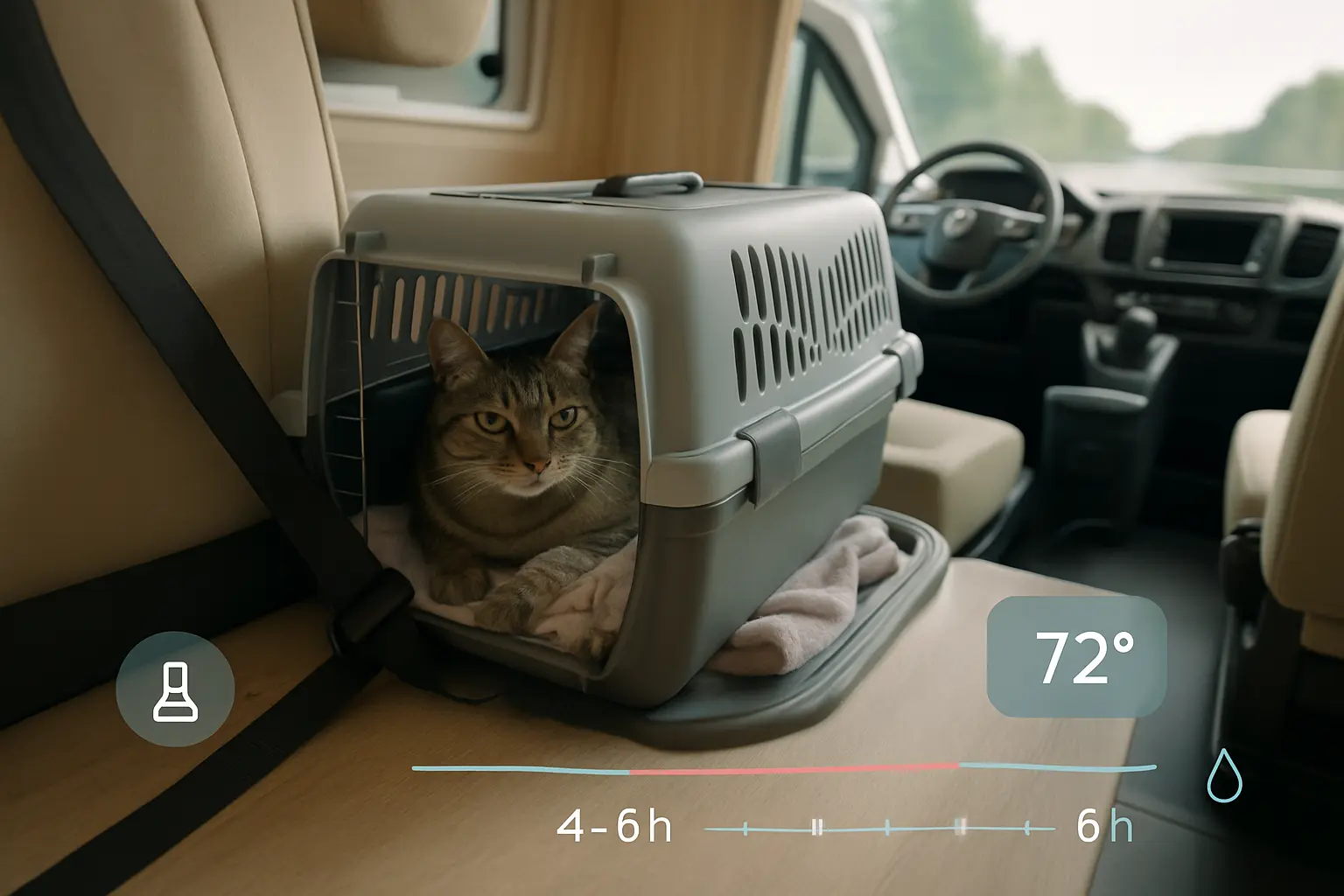
During travel days, the priority is minimizing risk while keeping the cat calm and stable. Each decision—from restraint type to stop schedule—affects safety and comfort. The guidance below focuses on practical steps that drivers and passengers can implement immediately. These practices help reduce injury risk, lower anxiety, and make long drives more predictable for both cat and owner.
Proper use of carriers, harnesses and restraints while driving
Choose a carrier or harness rated for vehicle use and sized so the cat can stand and turn. Hard-sided carriers resist crushing and provide secure anchor points. Soft carriers can work if they have internal structure and attach points. Use seatbelt loops, cargo straps, or anchor brackets to fasten carriers to the RV frame or seat. For harnesses, use crash-tested, pet-specific designs instead of standard walking harnesses. Attach harnesses to seatbelt anchors or dedicated tether points to limit forward motion during braking. Line carriers with non-slip, absorbent bedding to reduce sliding and absorb accidents. Avoid free-roaming cats while the vehicle is moving; unsecured cats become projectiles in a crash. Acclimate the cat to its restraint at home with short sessions and positive rewards. For step-by-step fastening tips, see how to secure a cat carrier in car.
Positioning carriers for airflow, visibility and motion comfort
Place carriers low and centered when possible to reduce sway and motion. A stable platform, such as the floor behind the passenger seat or a secured cabinet shelf, lowers the center of gravity. Avoid high shelves or unsecured counters that amplify jerking. Position carriers so the cat has a partial view of the road; some cats calm when they can see movement, while others prefer blocked views. Test which works by noting behavior on short drives. Ensure airflow without direct drafts on the cat’s face; use vents or fans to keep fresh air circulating, especially in warm weather. Keep carriers out of direct sunlight and away from heating ducts. If the RV’s passenger seat will be used, never place a carrier on a seat with an active airbag. Provide familiar bedding and a worn T-shirt for scent-based comfort. For calming techniques and carrier placement tips, consult how to calm down a cat in the car.
Reduce motion sickness: timing, food/water, and anti-nausea options
Minimize motion sickness by managing meals and hydration before travel. Offer a light meal four to six hours before departure, not immediately before the drive. Provide small amounts of water until about one hour prior, then limit free access during transit to reduce vomiting and litter mess. Schedule short stops for drinking and a litter break. Monitor for early signs of nausea: drooling, lip licking, restlessness, or heavy panting. If symptoms appear, pull over safely and allow the cat time in its carrier in a ventilated, stationary vehicle. For persistent problems, a veterinarian can prescribe anti-nausea medications such as maropitant (Cerenia) or recommend short-term sedatives for travel anxiety. Natural remedies like small amounts of ginger may help some cats, but always verify safety with a vet first. For context on travel-related panting and stress signals, see why do cats pant in the car.
Recommended daily driving limits and scheduled rest breaks
Limit daily driving to what keeps the cat calm and healthy. Many cat owners find 4 to 6 hours of driving per day works well, split into 2–3 hour segments. Plan rest breaks every 2–3 hours to offer water, check the litter box, and assess body language. During stops, keep the cat secured with a harness and short leash or inside a carrier before opening doors. Never allow free escape when doors or slides open. Use shaded, quiet rest areas and verify ventilation before allowing the cat any outdoor time. For overnight stops, select pet-friendly campgrounds with secure, low-traffic spaces. Also prepare a rest-stop kit: harness, leash, portable litter box, litter scoop, bottled water, treats, and a small towel. For practical tips on preventing escapes during breaks, review how to keep cats from escaping rv. Owners should test the planned schedule on shorter trips before committing to longer segments.
Managing campground life and leaving your cat unattended
Campground living requires a clear plan for a cat’s comfort and safety. Establish a routine that covers temperature, monitoring, and cleanliness before ever leaving a cat alone. Keep the RV secure, reduce outside stressors, and follow campground rules about unattended pets to avoid fines or conflicts.
Temperature monitoring and climate control best practices
Maintain a stable interior temperature between 65°F and 80°F. Use programmable thermostats and set conservative limits to prevent extreme swings. Close vents and blinds during midday sun. Provide a shaded sleeping spot and a warm bed at night. Place water bowls away from direct sunlight to keep water cool.
Monitoring options: cameras, sensors and remote alerts
Choose a camera with two-way audio and night vision to check behavior and soothe a cat remotely. Add motion and temperature sensors that send push alerts for sudden changes. Test remote apps and cellular backup before use. Place devices where they capture the cat’s favorite spots.
How long to safely leave a cat and prepping the space before you go
Limit unattended time to four to eight hours for most healthy cats. Before leaving, secure exits, hide cords, and lock screens. Refill food, water, and litter. For escape prevention tips, consult how to keep cats from escaping an RV. If plans run long, arrange a trusted check-in or pet-sitting service.
Cleaning routines and odor control for shared camp spaces
Empty the litter daily when possible. Use low-dust clumping litter and an odor-blocking mat under the box. Vent the RV after cleaning to dissipate smells. Store used litter in sealed bags and dispose at designated receptacles. Respect neighbors by keeping shared areas tidy and odor-free.
Safe outdoor time and supervised exploration
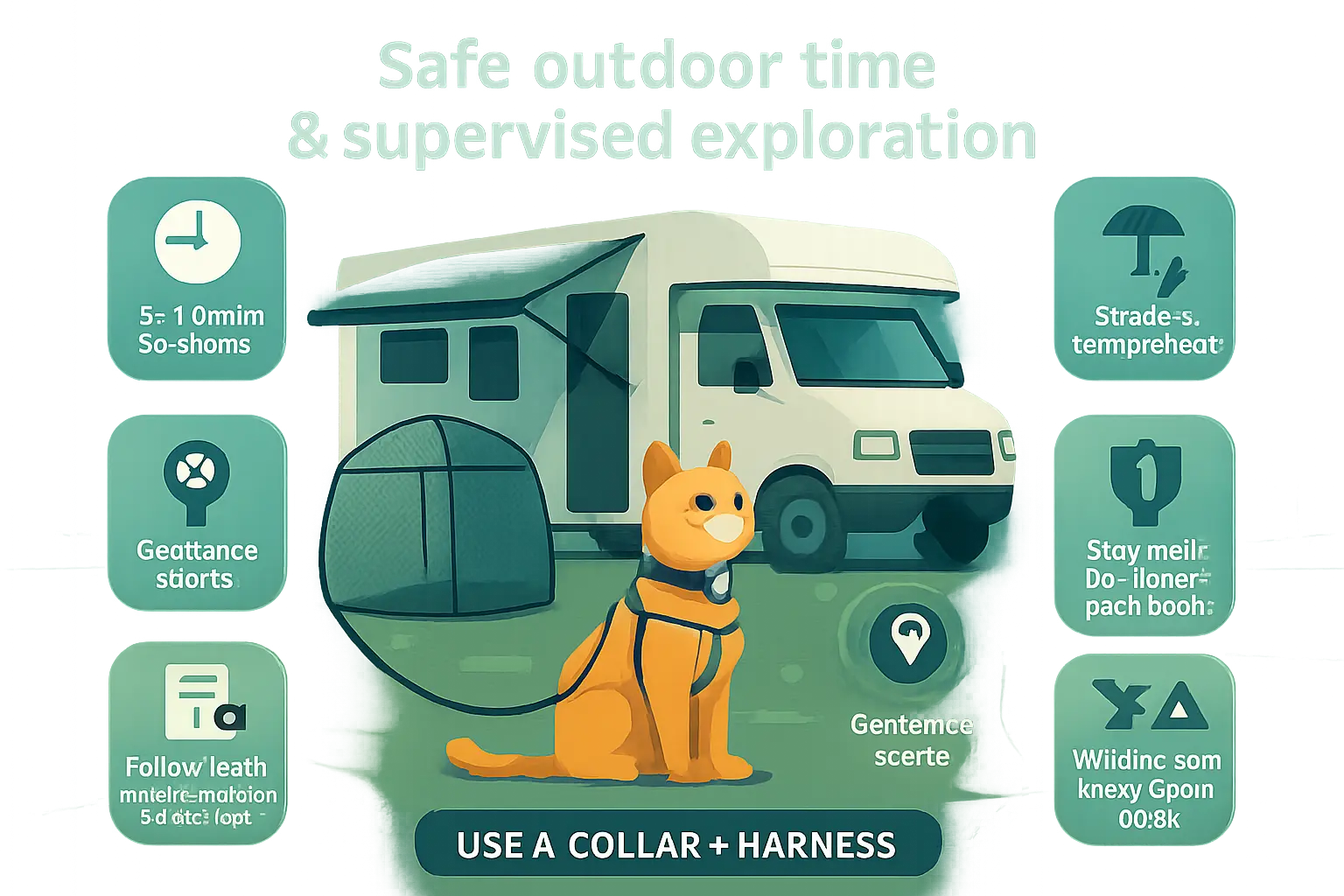
Owners should plan supervised outdoor sessions to let a cat enjoy fresh air without risking escape. Choose quiet, familiar spots near the RV and limit sessions to short, calm periods. Start by letting the cat explore a small, shaded zone close to the vehicle. Keep exits blocked and create a clear path back into the RV so the cat can retreat when stressed. Watch for overheating on hot days and cold-weather lethargy.
Use scent-based comfort items—an unwashed blanket or a favorite toy—to reduce anxiety during outdoor time. Rotate play and rest: five to ten minutes of active play followed by calm petting works best. Always approach new terrain slowly; check underbrush for holes, broken glass, or sticky bait before allowing the cat to step out.
For help reducing escape risk and learning practical containment strategies, review how to keep cats from escaping RV. Keep microchip contact info current and attach an ID tag before letting a cat outside. Schedule supervised sessions daily and record any unusual behavior to adjust routines.
Harness/leash training and trial walks near camp
Harness and leash training requires patience and a staged approach. Begin indoors with the harness for minutes at a time, rewarding calm behavior. Use a snug, padded harness that prevents wriggling but allows comfortable breathing. Avoid retractable leashes for training; use a short, lightweight leash to maintain gentle control.
Once the cat walks calmly inside, move to a quiet, enclosed area close to the RV. Keep early trial walks under ten minutes and end while the cat remains relaxed. Practice on different surfaces—grass, gravel, and pavement—so the cat learns to tolerate varied textures. If the cat freezes, wait and reward small movements rather than forcing steps.
Apply low-stress calming techniques and distraction methods from how to travel with a fussy feline to ease transitions. Train with short, daily sessions and bring high-value treats or a favorite toy. Track progress and increase walk time only when the cat shows consistent comfort.
Portable enclosures, catios and temporary fenced runs
Portable enclosures provide secure outdoor space without losing freedom. Choose collapsible pop-up catios or modular panels that anchor to ground stakes or wrap around picnic tables. Look for durable mesh with small holes to stop paws from slipping through and zippers that lock reliably.
Design the enclosure with shade, airflow, and a stable floor or ground cover. Include an elevated perch, scratching post, a small litter box, and fresh water. Place the enclosure on level ground and secure it against tipping from wind. For sandy or grassy campsites, use tent stakes and sandbags on corners.
When adding a temporary fenced run, ensure gate latches are double-secure and that no gaps exceed a cat’s ability to squeeze through. For ideas on adapting RV spaces, see RV modifications for cats. Inspect seams and zippers before each use and clean the enclosure regularly to avoid odors and pests.
Use GPS trackers, reflective collars and neighbor etiquette
Combining a GPS tracker with a breakaway, reflective collar gives owners both location data and visible identification. Choose a lightweight tracker with multi-day battery life and reliable cellular or satellite coverage for remote campsites. Test range and accuracy before leaving basecamp.
Attach a breakaway collar with reflective trim and a stamped tag showing contact and RV information. Program geofencing alerts and set a low-battery notification. Keep tracker apps up to date and verify permissions for location sharing with travel companions.
Practice considerate campsite behavior: keep cat sounds low, always pick up litter, and avoid letting a cat wander into neighbors’ spaces. For travel gear guidance applicable to trackers and collars, consult essential dog travel tips and gear for road trips. Register trackers, test alerts, and brief campground neighbors when a cat will explore outside.
Wildlife hazards, leash rules and campsite-specific checks
Campgrounds present diverse wildlife hazards. Scan the area for raptor activity, fox or coyote signs, and dens before allowing a cat outside. Avoid dawn and dusk outings when predators hunt most actively. Inspect ground for snake-prone spots, bait, and animal traps.
Always follow posted leash and pet rules. Some parks require leashes or prohibit off-trail wandering. Contact the campground office about local wildlife advisories and leash regulations before letting a cat explore. Use tick and flea preventives appropriate for travel, and check the cat’s coat after every outdoor session.
Secure food and trash to avoid drawing wildlife near the RV. Close doors and screens when returning inside, and keep night lighting low to reduce attraction to insects and predators. For beach- and shore-related hazard tips that translate to campsite risk awareness, see tips for taking cats to the beach. On arrival, perform a quick campsite sweep and note safe zones before any unsupervised outdoor time.
Emergency prep and health care on the road
The RV owner should treat health planning as part of trip logistics. Prepare emergency supplies, map out reliable veterinary care along the route, and create clear contingency plans if the cat becomes separated. Those steps reduce stress and speed response when a problem arises.
Build a compact cat first-aid and medication kit
Assemble a small, labeled kit that fits under a cabinet or in the carrier. Include sterile gauze, self-adhesive bandage, adhesive tape, blunt scissors, tweezers, a digital thermometer, styptic powder for bleeding, and saline eyewash. Add a soft muzzle substitute, disposable gloves, and a thin towel to restrain the cat safely. Pack prescription meds in original containers, with dosing notes and a pill organizer for daily use.
Store temperature-sensitive medicine in a small insulated bag with gel packs. Replace gel packs regularly and keep a thermometer in the bag. Add a copy of vaccination records, a photo of the cat, and a short emergency-care checklist that lists signs requiring urgent attention.
Train drivers and regular campers on basic bandaging and how to use the thermometer. Review contents before each trip and restock after use. For gear suggestions and travel-appropriate supplies, see essential dog travel tips and gear for road trips.
How to find and vet emergency and routine vets on route
Before departure, identify vets within two hours of planned stops. Use online directories, local veterinary association sites, and mapping apps to list clinics and emergency hospitals. Prioritize 24/7 emergency centers for remote stretches. Note phone numbers, addresses, and driving time from campgrounds.
Call each clinic to confirm services, current hours, and whether they accept out-of-area patients. Ask about experience with cats, hospitalization capacity, accepted payment methods, and whether they handle urgent surgery. Check online reviews for communication and wait-time patterns.
Maintain digital and printed medical records. Upload vaccination, prescription, and microchip details to a cloud folder and label the file for quick access. Share emergency contact and authorization details with a trusted friend who can act if the RVer becomes incapacitated. Create a one-page emergency contact sheet and store it in the glove box and the carrier.
Make calls for routine care at least a week before arrival to secure appointments. This advance planning reduces last-minute scrambling and improves outcomes.
Handling heat, cold, storms and power outages with a cat
Monitor interior temperatures continuously using a reliable thermometer. In heat, run A/C or shaded ventilation and provide multiple water sources. Freeze water bottles or use cooling mats to extend cool periods during short generator outages. Offer wet food sparingly to boost hydration. Watch for heatstroke signs: rapid breathing, drooling, weakness, or collapse; seek emergency care immediately if these appear.
In cold weather, use insulated bedding and a safe, low-voltage heated pad designed for pets. Avoid space heaters that tip or draw too much power. Seal drafts and keep a small supply of blankets. During storms, keep the cat in its carrier or a secure room to limit stress and escapes. Close blinds to reduce lightning flashes and sudden shadows that scare cats.
Prepare for multi-hour outages with a charged portable power station and extra fuel for a generator. Store extra water and a small supply of dry food. If prolonged loss of climate control occurs, relocate to pet-friendly emergency lodging or a friend’s home. For RV-specific measures and insulation tips, consult RV modifications for cats.
Boarding, sitter options and contingency plans if separated
Plan trusted care options before departure. Vet clinics, professional pet sitters, and short-term kennel care each suit different scenarios. Vet boarding offers medical oversight. Professional sitters can provide in-RV visits. Compile a short list of vetted sitters and boarding facilities near frequent stops and save contact details in the travel folder.
Create a clear, typed care plan to leave with any sitter. Include feeding schedule, litter preferences, medication instructions with doses and administration times, emergency contacts, and the clinic authorization to treat. Add a recent photo and written behavior notes, including handling cautions.
Prepare contingency documents that grant temporary medical and care authorization to a named person. Store digital copies and email access to the designee. If the cat becomes separated, report the loss to local shelters and update the microchip registry with trip locations. Keep a laminated ID card with vital info inside the carrier.
For practical tips on calming and handling a stressed cat during transfers or sitter handoffs, see how to travel with a fussy feline. Upload care documents to the cloud and share access with sitters before handoff to speed care.
Summary
15 Essential Tips for Traveling with Cats in an RV equips owners with step-by-step, safety-first guidance—from pre-trip veterinary prep and ID updates to gradual acclimation, RV cat-proofing, and on-the-road routines. It outlines how to plan pet-friendly routes with emergency vets, set up compact litter/feeding systems, and use carriers and restraints correctly to prevent injuries.
The post emphasizes predictable routines, secure containment, and redundancy against escapes. With practical campground protocols, supervised outdoor strategies, and thorough emergency planning, RVers can create a calm, low-risk travel experience their cats can reliably handle.
Key Takeaways
- Start 4–6 weeks ahead: book a vet check, update microchip details, duplicate medical records, and organize labeled medications with printed dosing notes.
- Test temperament first: run short drives and overnights, monitor eating/litter habits, and proceed only if stress stays manageable; use positive reinforcement and consult a behaviorist when needed.
- Desensitize and set routines: make the carrier a safe resting spot, keep consistent feeding/play/sleep times, and respond early to stress signs by pausing and providing a quiet refuge.
- Cat‑proof the RV: secure cabinets and appliances, reinforce screens and vents, anchor hideaways/perches and the litter box, and provide scratchers with washable covers.
- Drive smart and safe: secure a vehicle-rated carrier or harness low and centered, manage meals/water to reduce motion sickness, and cap driving to about 4–6 hours with 2–3 hour breaks; never allow free-roaming while moving.
- Plan for camp and emergencies: monitor temperature (65–80°F) with sensors/cameras, limit unattended time to 4–8 hours, supervise outdoor time with harness/enclosures/GPS, and keep a first-aid kit plus an offline vet list for every stop.
FAQ
- What documents and IDs should an RV traveler carry for a cat? Keep printed and digital copies of vaccination records, prescriptions with dosing, microchip registration, and proof of ownership. Update microchip contact info and use an ID tag with a cell number and temporary RV contact.
- How can someone tell if their cat is suited to RV life? Run staged trials—short drives and single overnights—while tracking appetite, litter use, and vocalization. Persistent hiding, aggression, or refusal to eat signals that RV travel may not be appropriate.
- What is the safest way to secure a cat while driving an RV? Use a hard-sided, vehicle-rated carrier or a crash-tested harness anchored to seatbelt points or cargo anchors, placed low and centered for stability. Never allow free-roaming during transit.
- How can motion sickness be reduced on travel days? Feed a light meal 4–6 hours before departure, limit water right before driving, ensure steady airflow without direct drafts, and schedule frequent breaks. Ask a veterinarian about anti-nausea options if symptoms persist.
- How long can a cat be left alone in an RV, and how should the space be prepared? Most healthy cats can be left 4–8 hours with stable climate control, water, food, and a clean litter box. Secure exits, reinforce screens, use temperature and camera monitoring, and arrange a sitter if plans run long.

